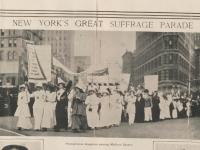This lesson illustrates the struggle women endured economically, politically, and socially in the United States during the nineteenth and twentieth centuries. Through the analysis of the Hucksters' Petition, National Woman Suffrage Association's Constitution, and the Equal Rights Amendment brochure students will understand the struggle women encountered in their fight to obtain social equality, economic and political rights.
The petition of women hucksters (street vendors) is an attempt for poor workingwomen to gain economic and social recognition in the markets of Philadelphia. They sought redress through the political process; this tradition would be followed by other women's groups trying to gain suffrage rights and ultimately equality. The National Women's Suffrage Association and Equal Rights Amendment brochure clarify what both movements hoped to achieve.
After careful reading of the three documents, students should have an understanding of the constant conflict these organizations encountered in their struggle for equality.

